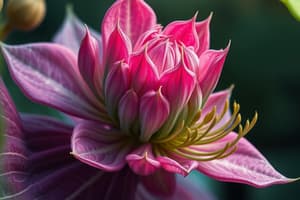Podcast
Questions and Answers
Micromorphology examines the ___ structures of plants.
Micromorphology examines the ___ structures of plants.
- Microscopic (correct)
- Cytoplasmic
- Organellar
- Macroscopic
Which of the following plant organs has been studied extensively using micromorphological techniques?
Which of the following plant organs has been studied extensively using micromorphological techniques?
- Stems
- Leaves (correct)
- Flowers
- Roots
What type of microscopy was used in the comparative study of leaf micromorphology in Korean Piperales?
What type of microscopy was used in the comparative study of leaf micromorphology in Korean Piperales?
- Confocal microscopy and fluorescence microscopy
- X-ray crystallography and nuclear magnetic resonance spectroscopy
- Light microscopy and scanning electron microscopy (correct)
- Transmission electron microscopy and atomic force microscopy
Which of the following structures were NOT identified in the study of Korean Piperales leaf micromorphology?
Which of the following structures were NOT identified in the study of Korean Piperales leaf micromorphology?
What is the significance of studying seed micromorphology?
What is the significance of studying seed micromorphology?
What is the primary significance of seed coat micromorphology in the study of Impatiens species?
What is the primary significance of seed coat micromorphology in the study of Impatiens species?
In the context of Pegmatisectum seeds, what role do ergastic cells play?
In the context of Pegmatisectum seeds, what role do ergastic cells play?
Which of the following statements about leaf micromorphology in the genus Asarum is true?
Which of the following statements about leaf micromorphology in the genus Asarum is true?
What is the primary function of ergastic cells in plants?
What is the primary function of ergastic cells in plants?
Which of the following statements about micromorphology is true?
Which of the following statements about micromorphology is true?
Flashcards are hidden until you start studying
Study Notes
Plant Morphology: An Examination of Micromorphology and Ergastic Cells
Introduction
Plant morphology refers to the physical and structural features of plants, including their cells and tissues. Two specific areas within plant morphology are micromorphology and ergastic cells. Micromorphology focuses on the minute structures of plants, particularly at the cellular level, while ergastic cells refer to specialized cells that play specific roles within plants. In this article, we will explore these topics in detail.
Micromorphology
Micromorphology refers to the detailed examination of microscopic structures in plants, such as the surface features of leaves and seeds. Leaves, for instance, are highly polymorphic organs in plants, possessing significant morphological diversity. Their micromorphological characteristics have been employed in taxonomic studies to identify various taxa. For example, a comparative study was performed on the leaf micromorphology of Korean Piperales using light and scanning electron microscopy to evaluate their taxonomic significance. These findings revealed that secretory idioblasts were present on all taxa studied except Aristolochia, while three main types of trichomes were identified—glandular trichome, simple multicellular trichome, and two-armed multicellular Y-shaped trichome.
Studies on seed micromorphology have also been instrumental in understanding plant evolution. One example involved the examination of Impatiens species, where seed coat micromorphology was found to have taxonomic significance in distinguishing between different species. In another case, the micromorphology of Pegmatisectum seeds was studied to gain insights into its ecological adaptive strategy.
Ergastic Cells
Ergastic cells are specialized cells that perform specific functions in plants. For example, in the genus Asarum, leaf micromorphological characteristics were found to be useful for taxonomic identification and authentication of plants. However, there has been little attention paid to the leaf micromorphology of Asarum, despite its potential significance in systematic studies.
In the context of seeds, ergastic cells can play crucial roles in germination. For instance, studies on the micromorphology of Pegmatisectum seeds revealed that these cells contribute to the ecological adaptive strategy of the plant.
Conclusion
In conclusion, micromorphology and ergastic cells are essential aspects of plant morphology that provide valuable insights into the structure and function of plants. Micromorphology offers a detailed understanding of minute structures, such as leaf surfaces and seed coat ornamentation, which can be used for taxonomic identification and authentication. Ergastic cells, on the other hand, perform specific functions within plants, contributing to their overall growth and survival. Both micromorphology and ergastic cells are therefore essential components of the broader field of plant morphology.
Studying That Suits You
Use AI to generate personalized quizzes and flashcards to suit your learning preferences.





